But first:
I made a major error in last week’s Post about Christian Nationalism, for which please forgive me.
I said the United States of America was founded not as a Christian nation but as a “secular” nation. I meant to say “non-sectarian”: with no established “sect” or religion. Secular means “having nothing to do with religion”. That was not the case.
America was founded as a religious nation in which “all are endowed by their Creator with certain inalienable rights” – eight out of the thirteen original colonies had established Churches – but with freedom of religion for all.
Our Founding Fathers valued religion and thought it necessary for the welfare of society. This is from George Washington: “Of all the dispositions and habits which lead to political prosperity, religion and morality are indispensable supports. In vain would that man claim the tribute of patriotism, who should labor to subvert these great pillars of human happiness, these firmest props of the duties of men and citizens…” To make the point that this applies to all, Washington wrote these same sentiments to a Jewish synagogue in Rhode Island.
Here are some quotations from a few of the Founding Fathers regarding their personal beliefs, which ranged from “believing Christian” to Deist to valuing only the teachings of Jesus: https://www.learnreligions.com/christian-quotes-of-the-founding-fathers-700789
I have made this correction in the text of last week’s Post.
Saint Mary Magdalene
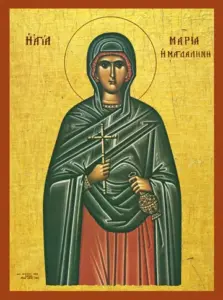
whose feast day we celebrated on July 22
I said last week that writing about Mary Magdalene would be simple. It wasn’t. I discovered that there is a vast amount of material about her, both ancient and contemporary. Next to the Mother of God herself, Mary Magdalene has been one of the most popular of female saints, in both the East and the West.
This seems odd, in light of the fact that we actually know very little about her. In the Gospel accounts she is mentioned fourteen times * – but much of this is duplication. We learn a little more from earliest Church tradition. And that’s all.
- Matthew (27:56,61; 28:1), Mark (15:40,47; 16:1, 16:9), Luke (8:2; 24:10), John (19:25; 20:1,11,16,18)
First let’s look at these texts in their Gospel sequence. I hope you’ll take a little time at look up these passages for yourself.
The following is an unsolicited commercial for the best source of icons I know, saintpaulsicons.com – a monastery near me in western Wisconsin, where they are continuing the work of the former Saint Isaac’s Skete. The next four icons are available from there.
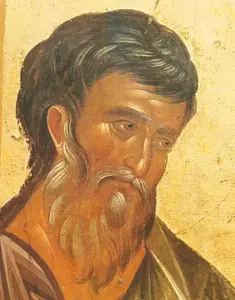
Matthew tells that Mary Magdalene had known Jesus in Galilee, where she was one of the women who followed Him, “ministering” to Him, He describes her brave presence at the Crucifixion of Christ, and says she and “the other Mary” sat by the tomb. She was one of the Myrrh-bearing Women who found the empty tomb, when the angel told them to go to the Apostles, announcing the Resurrection. As they were returning Jesus appeared to them. They held His feet, worshiping Him.
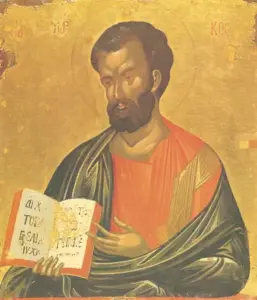
Mark briefly recounts the same narrative. Regarding Mary Magdalene he adds two pieces of information: 1) She was first to see the risen Lord, which seems to contradict Matthew’s account where all the Women together were first to see Him. We’ll talk about that in a minute. 2) Almost as an afterthought, he mentions that Christ had cast seven demons out of her.
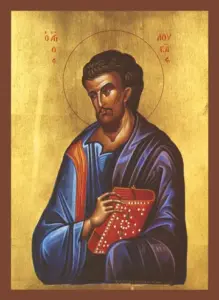
Luke adds that during His ministry throughout Galilee, the Twelve Apostles went with Him, as did some women including Mary Magdalene “out of whom had come seven demons”.
I’ve always wondered what peoples’ first reaction was when they first saw this group of young men traveling around, accompanied by a few young women. What would you think?
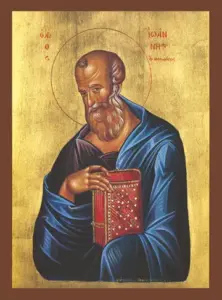
John has Mary Magdalene now at the foot of the Cross, standing with His Mother and John the Apostle. She was apparently there as the Lord gave His Mother into the care of John. “Son, behold your Mother. Mother, behold your son.”
Then, as he often did, John adds an episode which was not in the Synoptic Gospels: the full story of how Mary Magdalene was first to see the risen Christ: John chapter 20. It is a numinous story, beautiful and powerful beyond the words themselves. It gives me the holy chills every time I hear it. In our liturgical cycle, it is read only at Sunday Matins/Orthros once every eleven weeks, which means (things being what they are) that scarcely anyone hears it. Therefore let me print it here. Please read it as you would read a prayer, opening your heart and mind to God. Stand in the garden with Mary.
John 20:1-18. “Now the first day of the week Mary Magdalene went to the tomb early, while it was still dark, and saw that the stone had been taken away from the tomb. Then she ran and came to Simon Peter, and to the other disciple, whom Jesus loved, and said to them, “They have taken away the Lord out of the tomb, and we do not know where they have laid Him.” Peter therefore went out, and the other disciple, and were going to the tomb. So they both ran together, and the other disciple outran Peter and came to the tomb first. And he, stooping down and looking in, saw the linen cloths lying there; yet he did not go in. Then Simon Peter came, following him, and went into the tomb; and he saw the linen cloths lying there, and the handkerchief that had been around His head, not lying with the linen cloths, but folded together in a place by itself. Then the other disciple, who came to the tomb first, went in also; and he saw and believed. For as yet they did not know the Scripture, that He must rise again from the dead. Then the disciples went away again to their own homes
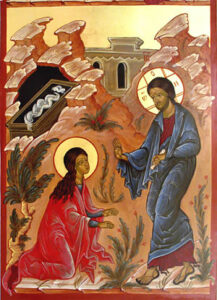
“But Mary stood outside by the tomb weeping, and as she wept she stooped down and looked into the tomb. And she saw two angels in white sitting, one at the head and the other at the feet, where the body of Jesus had lain. Then they said to her, “Woman, why are you weeping?” She said to them, “Because they have taken away my Lord, and I do not know where they have laid Him.” Now when she had said this, she turned around and saw Jesus standing there, and did not know that it was Jesus. Jesus said to her, ‘Woman, why are you weeping? Whom are you seeking?’”
“She, supposing Him to be the gardener, said to Him, ‘Sir, if You have carried Him away, tell me where You have laid Him, and I will take Him away.’ Jesus said to her, ‘Mary!’ She turned and said to Him, ‘Rabboni!’ (which is to say, Teacher). Jesus said to her, ‘Do not cling to Me, for I have not yet ascended to My Father; but go to My brethren and say to them, “I am ascending to My Father and your Father, and to My God and your God.’” Mary Magdalene came and told the disciples that she had seen the Lord, and that He had spoken these things to her.”
How do we harmonize this with Matthew’s account that the Women together went to the tomb and then saw the risen Lord as they returned to the city? Fairly easily, I think. Keep in mind that the Women were so shocked and excited that it was hard to keep the details straight. Perhaps Mary went to the Garden before the other Women. Or perhaps she remained and saw Christ there, while the others hurried to tell the other disciples.
Did you notice that in Mary’s account, she was not allowed to touch Him. Had some “process” which required ascending to the Father not yet taken place? In Matthew the Women touched His feet. Had the “process” been completed? … A mystery.
The Church has always honored Saint Mary Magdalene as first to see the risen Lord, “isapostolos” in Greek, “Equal to the Apostles”, who first proclaimed the Resurrection to the Apostles.
And that’s all the Scriptures tell us about Saint Mary Magdalene.
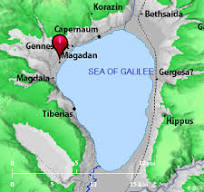
It seems very likely that she was from the town of Magdala, just to the southwest of Capernaum, which was the Lord’s “headquarters” during His Galilean ministry – that she met Him as He visited there, while was preaching and healing through Galilee.
What were the seven demons which Jesus cast out of her? It doesn’t say – which has given leave to rampant speculation: Was she a prostitute? a druggie? Had she committed all the seven deadly sins (which were actually a medieval listing) or ? ? ? My guess is that she suffered from exactly what it says. Like the Gadarene demoniac, from whom Christ cast out “a legion” of demons, Mary suffered from multiple demonic possession, so that she was entirely out of control of herself, and Our Lord cast them all out and restored her. No wonder she followed Him ever after with such gratitude.
Why does John’s Gospel include the story about how Mary Magdalene first saw the risen Lord? Here’s the best guess: Earliest Church tradition says that she joined John the Apostle (and perhaps the Lord’s Mother, if she was still there) in Ephesus, where she died. John got the story directly from her.
And that, brothers and sisters, is all we really know about Saint Mary Magdalene. She has always been much loved and greatly venerated in the Orthodox Church.
Legends and Myths about Saint Mary Magdalene
There is the story of how Magdalene went to the Emperor Tiberias Caesar, gave him a red egg (or perhaps it miraculously turned red in her hands), saying “Christ is risen”. Lovely legend, but I’m afraid there’s not any evidence that it happened.
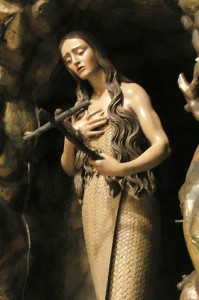 Was she a reformed prostitute? No. Nevertheless, in Western Christianity she came to be identified with “the sinful woman” who washed Jesus’ feet with her hair. (Luke 7:36-50) The Scriptures say no such thing. Nevertheless, in the year 591 Pope Gregory I pronounced her to be that “sinful woman” – early evidence of the development of Latin Tradition without reference to Holy Scripture.
Was she a reformed prostitute? No. Nevertheless, in Western Christianity she came to be identified with “the sinful woman” who washed Jesus’ feet with her hair. (Luke 7:36-50) The Scriptures say no such thing. Nevertheless, in the year 591 Pope Gregory I pronounced her to be that “sinful woman” – early evidence of the development of Latin Tradition without reference to Holy Scripture.
In 1969, Pope Paul VI quietly removed the identification of Mary Magdalene with the “sinful woman” from the Roman Calendar. But it was too late. The picture of her as a former prostitute has persisted in popular culture (books, movies The Last Temptation of Christ, Jesus Christ Superstar) where she remains the fallen woman, and it seems unlikely to ever go away.
However, there is another entirely different Mary Magdalene – a myth with no Scriptural or historical reference of any sort – that she was actually chief of the Apostles and also (hang on, folks) married to our Lord Jesus.
I’m talking about this hesitantly, only to give you a sort of inoculation against this nonsense, because (as I just discovered) if you go on-line and search for Mary Magdalene, you’ll find many contemporary books and papers on this bizarre topic, presented as if it is the Gospel truth. It is not. I suppose it comes from a natural desire to know more about her, but it is just not right – it is very wrong – to fabricate stories and call them true.
When did these myths arise? They began to be promoted by Gnostic writers as early as the late First Century AD.
An Interlude about Gnosticism
“Gnosis/γνῶσις means “knowledge”. Gnostics said, to put it bluntly, that Jesus had given the Apostles a fake Gospel to share with us ordinary folks who are not intelligent enough to grasp the Real Thing. Gnostics claimed that the Lord had shared secret, hidden, esoteric knowledge of the Actual Truth with a few intimates, those intelligent and superior enough to grasp it. This “knowledge” was written in a number of books, some of which have been rediscovered in modern times, and most of which disagree with each other. A great deal has been made of them in recent times.
Some of the Myths about Saint Mary Magdalene
Here is an example, taken from a fragment of the spurious Second Century Gnostic Gospel of Mary [Magdalene]:
“Peter said to Mary, “Sister, we know that the Saviour loved you more than the rest of women. Tell us the words of the Saviour which you remember – which you know (but) we do not, nor have we heard them.” Mary answered and said, “What is hidden from you I will proclaim to you.” And she began to speak to them these words: “I,” she said, “I saw the Lord in a vision and I said to him, ‘Lord, I saw you today in a vision.’ He answered and said to me, ‘Blessed are you that you did not waver at the sight of me. For where the mind is, there is the treasure.’ I said to him, ‘Lord, how does he who sees the vision see it through the soul or through the spirit?’ The Saviour answered and said, ‘He does not see through the soul nor through the spirit, but the mind which [is] between the two – that is [what] sees the vision…”
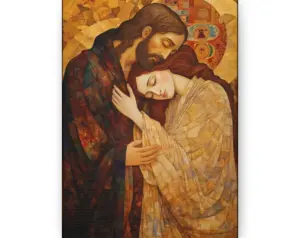
The equally spurious Gospel of Philip takes it quite a bit further: “The Lord…loved Mary more than the disciples and he often kissed her on the mouth …” And Peter said, “Sister, we know that the Lord has loved you differently from other women. He said to you, which you remember and we do not know about … […] Is it possible that the Lord has spoken with a woman about secrets we do not know about? “’
Some of this got grossly obscene. I’m not going to tell you about it.
In the Medieval West, the mythology about Mary Magdalene went wild. The following is from the book The Royal Bloodline: The Descendants of Jesus and Mary Magdalene by Donald V. Watkins, (2021). This is based on medieval texts – fanciful writings by authors with very active imaginations.
“Therefore, I used hundreds of independent sources and documents to reconstruct and corroborate the life, marriage, parenthood, and genealogy of Jesus and Mary Magdalene, as well as the genealogy of their descendants. After Mary Magdalene, her children, Jesus’ mother, and their entourage escaped to France, the Royal Bloodline perpetuated itself, intact and incognito for the next four hundred years. During the fifth century, this Royal Bloodline intermarried with the Royal Bloodline of the Franks, thus engendering the Merovingian dynasty. From there, the Bloodline continued through the Carolingians (who deposed the Merovingian dynasty from its throne) to William the Conqueror of England, and from there to Great Britain, Ireland, France, Germany, and other parts of the world… By the fifteenth century, King Louis XI of France acknowledged Mary Magdalene as the source of the French royal line. King Charlemagne, who ruled Hapsburg, recognized her royalty, as well. Today, there are at least a dozen families in Europe who are of Merovingian descent. They include the Houses of Hapsburg-Lorraine, Plantard, Luxembourg, Montpezat, Montesquieu, and others. In Britain, various branches of the Sinclair, Stuart, and Devonshire families are descendants of the Royal Bloodline”.

There are some Renaissance paintings of Mary Magdalene which (perhaps I’m just too benighted to appreciate fine art) depict her so naked and salacious that they seem to me to make her only a “love interest”. This is one of the milder ones. Is it Venus? No, it’s Holy Mary Magdalene.
Here’s another contemporary and more detailed example: from Mary Magdalene: Consort of Jesus and Apostle to the Apostles, by Anne Baring (recent – can’t find the date), which tells us, for example, who got married at the Wedding of Cana in Galilee. It was none other than Jesus and Mary Magdalene!
“Mary Magdalene was of Syrian descent. Her family name was Mary of Bethany, after the village where her family home was. She was a Syrian priestess in her own right by the time she married Jesus. Her father was of Syrian royal ancestry which is why the marriage at Bethany (with the double anointing of Jesus) had a Syrian character. Her mother was also of royal descent from the house of the Hasmodaean Maccabees…. Her marriage to Jesus in AD 33 was a dynastic marriage contract, uniting two important dynastic family lines… Their first child was named Sarah. She would later be known as Sarah-Damaris Bat Yeshuah Princess of West-Francs. Her father was Jesus of Nazareth and her mother was Mary Magdalene. The couple also sired a son named Joseph, who would later be known as Joseph Rama Theo ben Jesus Bishop of Saraz.”
Well, at least in these myths she was not a prostitute!
Why have people believed these things? Well, why do Seventh Day Adventists believe that the Second Coming of Christ already occurred invisibly in 1914? Why do Mormons, good people that they are, believe that the true Gospel was finally revealed by the angel Moroni to Joseph Smith in upstate New York on September 21, 1823, written on golden tablets which have since been taken back into heaven?
I can’t say that I know. I guess just because someone said so. As contemporary history continues to show, many people will eagerly believe myths and lies, without asking any questions.
Enough of this. More than enough. To repeat, I’ve included these fascinating but mythical accounts only to warn you that if you look up Saint Mary Magdalene online, or search in bookstores, you’ll find a multitude of this kind of (forgive me… I’m temped to use two naughty words here, but I won’t).
Back to Reality
There was and is a reason why the Church from earliest times has accepted only four Gospel accounts of the life of Jesus Christ, including what little we know of Saint Mary Magdalene. The reason is that these were written by Apostles themselves or those who got the story directly from the Apostles – eye-witnesses to what actually happened.
Isn’t that enough?
And isn’t that enough to make us love and revere Magdalene? This woman healed and freed by Jesus from the terrible condition had afflicted her, so grateful that she followed Her Lord for the rest of His time on earth – who stood with Him and His Mother at the foot of the Cross, who was privileged to be first to see the Risen Lord.
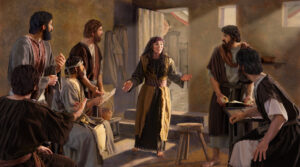
Go back and read John 20 again. Share her sorrow as she stands in the garden – and her joy beyond all telling as she hears the Voice she so loves say to her “Mary”. Hear her, as she stands breathlessly, in the early sunshine of the first Paschal dawn, in wonder and amazement, saying quietly to the Apostles, “I have seen the Lord.”
Isn’t that enough to make us love her?
Her supposed relics are scattered from East to West, including a tooth displayed at the Metropolitan Museum of Art in New York City. Displayed in a museum? Can’t someone do something about this?

Saint Mary Magdalene, please forgive the world for what they have done to you.
Holy Mary Magdalene, please pray to Christ our God for the salvation of our souls.
Next Week: This ‘n’ that.
Week after Next: I think we’ll talk about The Transfiguration.